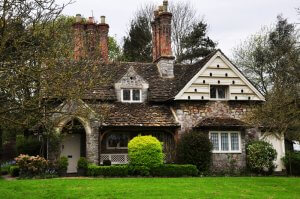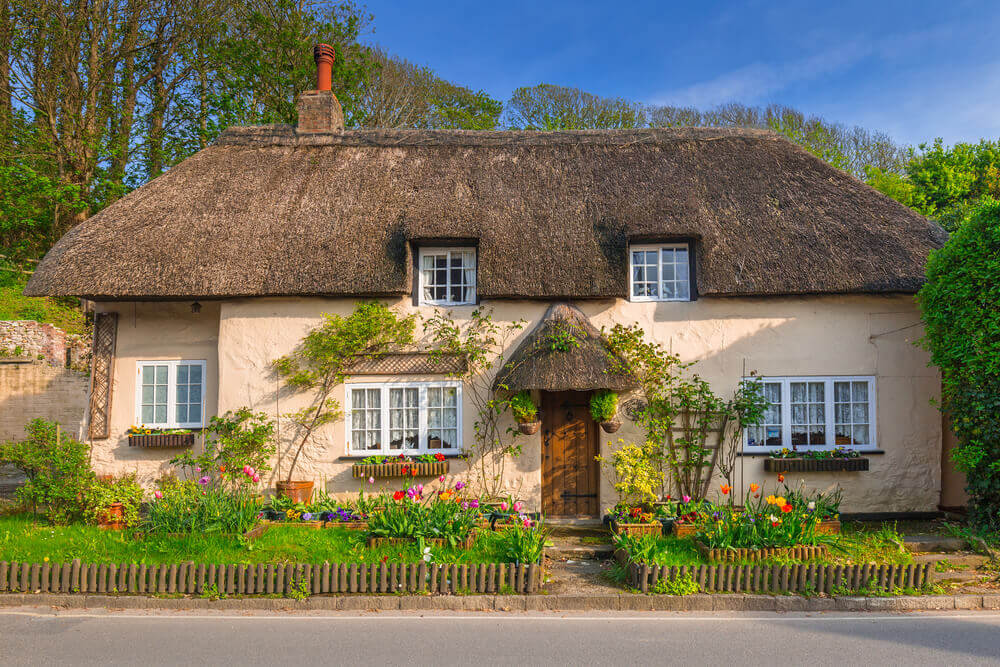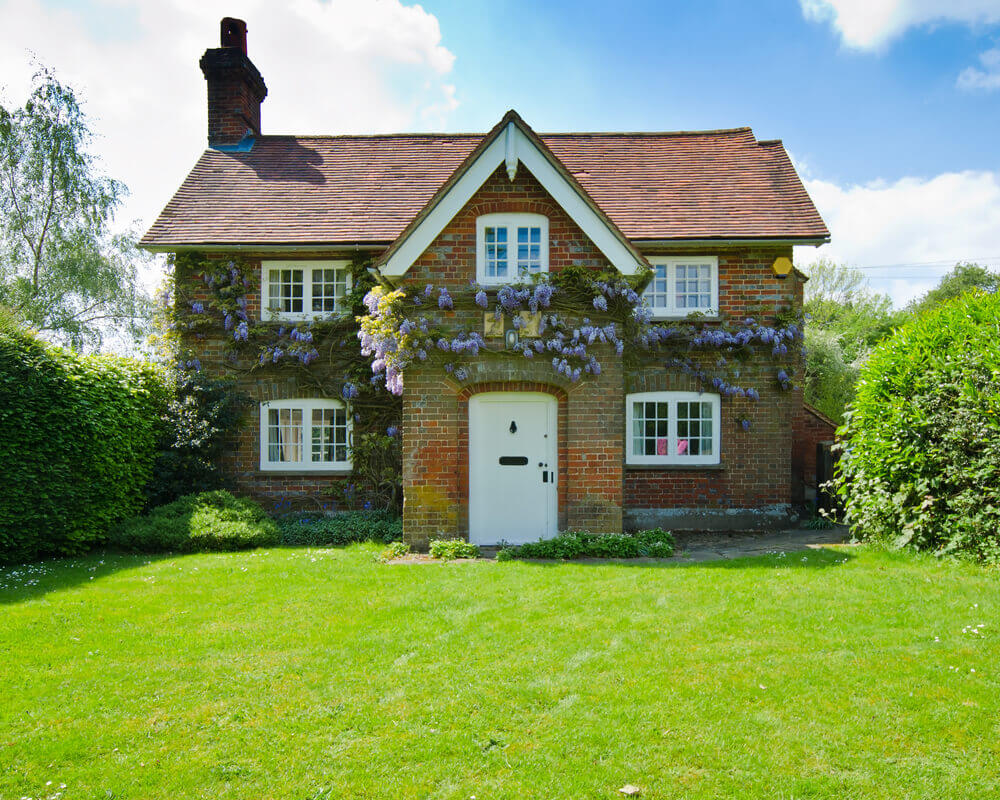Gorgeous English Cottage-Style Houses

The origin of these marvelous English cottage-style houses dates far back in time. They’re from the period when farming communities were the life of the English countryside. These are houses that preserve a reminiscent air of rural life in the past.
It’s one of the prettiest and most charming architectural styles you’ll find. English cottages have a warmth that cement and steel just can’t give.
This is probably why this style gives us houses that are visually appealing, full of tradition, with their gorgeous woodwork and natural brick. Intricate roofs, intimate front porches, and generous windows mark this unique style.
It was in the late 19th century, in the midst of the Victorian age, when architects again started to use the older construction methods. The rich style known as Old English returned to popularity, with the magnificent English cottage as its icon.
The return of the English cottage style

Around 1870, the architects Richard Norman Shaw and George Devey restarted this style that was inspired by the houses of English farmers. It was a direct competitor to the current architectural style of the time, a Tudor style house that was a reminder of a bygone medieval English style.
In comparison to these houses, the English cottage is smaller and cozier. How is the exterior architecture of the house designed? The answer is, in such a way so that the viewer can imagine the inside just by looking at the outside.
That’s why the gorgeous facades of English cottages are like an open invitation. They conjure up the idea of a warm and comfortable home inside.
Characteristics of the typical English cottage

Various prominent features characterize this style. Together they make up that typical picture-postcard look.
Their roofs are steeply pitched with cross gables and include traditional attic windows cutting into the roofline. You’ll occasionally see a thatched roof. The original outer layer of these houses was of stucco and brick.
In more current English cottage-style houses, you’ll find exterior coverings in stone, with decorative timber interlaced. They also have huge chimneys that you can see from outside, of stone or brick, usually at the front of the house.
You’ll commonly see pot plants adorning the house. The typical door to the English cottage is curved or semicircular, with ornate ironwork.
Another characteristic is a front porch, a closed entry with a catslide-style roof, that has one side sloping down almost to the ground. This kind of roof allows the roofline to descend below the normal level of the eaves, adding more space on one side.
The windows in an English cottage are large, tall and they generally open wide using hinges on each side. The houses are asymmetrical and the rooms are all slightly uneven. This gives each room a unique, cozy feel.
A common feature on the outside of the house is decorative timber framework that reaches up to the roof.
A poetic style

In 1928, in the Home Builder’s Catalog, we find the following description regarding the English cottage style:
“The elevated, evanescent spirit of Gothic architecture seems to have little to do with domestic buildings. And today it is impossible to find such outstanding features as high vaulted ceilings, delicate buttresses and royal stained glass windows apart from in medieval castles. However, we can look at it in a broader way if we remember the wish of freedom to float, and since romance itself is at the core of Gothic architecture, we can find a certain measure of domestic expression of it in this style of house.”
English cottage-style houses – little treasure chests

The outside of English cottage-style houses is an expression of the inside. The first thing that’s designed is the floor plan. Despite its complexity, the exterior is created to reveal what’s hidden inside.
It may be the most flexible style of them all. Symmetry is sacrificed, but a balance is maintained through the different architectural aspects.
The result of the English cottage-style is a gorgeous mixture of different shapes. The external walls are all different sizes and are full of ornamental details. This is the perfect style for those who want to exhibit their personality through their home.
The modern revival of this style became popular in the United States from 1915 until 1940. It’s an architectural style that’s capable of creating the impression of a great mansion from just a simple house with an attic. It is still tremendously popular and is an influence on current British and American architecture.
Imitating country life

You know what they say: you never get a second chance to give a first impression. This is one of the principles of this architectural style that is impressive straight from the first glance. It decorates the whole of the outside of the house with things from nature.
From the climbing roses to the wisteria, these houses are inspiring examples of how a little creativity together with nature can make a difference.
The origin of these marvelous English cottage-style houses dates far back in time. They’re from the period when farming communities were the life of the English countryside. These are houses that preserve a reminiscent air of rural life in the past.
It’s one of the prettiest and most charming architectural styles you’ll find. English cottages have a warmth that cement and steel just can’t give.
This is probably why this style gives us houses that are visually appealing, full of tradition, with their gorgeous woodwork and natural brick. Intricate roofs, intimate front porches, and generous windows mark this unique style.
It was in the late 19th century, in the midst of the Victorian age, when architects again started to use the older construction methods. The rich style known as Old English returned to popularity, with the magnificent English cottage as its icon.
The return of the English cottage style

Around 1870, the architects Richard Norman Shaw and George Devey restarted this style that was inspired by the houses of English farmers. It was a direct competitor to the current architectural style of the time, a Tudor style house that was a reminder of a bygone medieval English style.
In comparison to these houses, the English cottage is smaller and cozier. How is the exterior architecture of the house designed? The answer is, in such a way so that the viewer can imagine the inside just by looking at the outside.
That’s why the gorgeous facades of English cottages are like an open invitation. They conjure up the idea of a warm and comfortable home inside.
Characteristics of the typical English cottage

Various prominent features characterize this style. Together they make up that typical picture-postcard look.
Their roofs are steeply pitched with cross gables and include traditional attic windows cutting into the roofline. You’ll occasionally see a thatched roof. The original outer layer of these houses was of stucco and brick.
In more current English cottage-style houses, you’ll find exterior coverings in stone, with decorative timber interlaced. They also have huge chimneys that you can see from outside, of stone or brick, usually at the front of the house.
You’ll commonly see pot plants adorning the house. The typical door to the English cottage is curved or semicircular, with ornate ironwork.
Another characteristic is a front porch, a closed entry with a catslide-style roof, that has one side sloping down almost to the ground. This kind of roof allows the roofline to descend below the normal level of the eaves, adding more space on one side.
The windows in an English cottage are large, tall and they generally open wide using hinges on each side. The houses are asymmetrical and the rooms are all slightly uneven. This gives each room a unique, cozy feel.
A common feature on the outside of the house is decorative timber framework that reaches up to the roof.
A poetic style

In 1928, in the Home Builder’s Catalog, we find the following description regarding the English cottage style:
“The elevated, evanescent spirit of Gothic architecture seems to have little to do with domestic buildings. And today it is impossible to find such outstanding features as high vaulted ceilings, delicate buttresses and royal stained glass windows apart from in medieval castles. However, we can look at it in a broader way if we remember the wish of freedom to float, and since romance itself is at the core of Gothic architecture, we can find a certain measure of domestic expression of it in this style of house.”
English cottage-style houses – little treasure chests

The outside of English cottage-style houses is an expression of the inside. The first thing that’s designed is the floor plan. Despite its complexity, the exterior is created to reveal what’s hidden inside.
It may be the most flexible style of them all. Symmetry is sacrificed, but a balance is maintained through the different architectural aspects.
The result of the English cottage-style is a gorgeous mixture of different shapes. The external walls are all different sizes and are full of ornamental details. This is the perfect style for those who want to exhibit their personality through their home.
The modern revival of this style became popular in the United States from 1915 until 1940. It’s an architectural style that’s capable of creating the impression of a great mansion from just a simple house with an attic. It is still tremendously popular and is an influence on current British and American architecture.
Imitating country life

You know what they say: you never get a second chance to give a first impression. This is one of the principles of this architectural style that is impressive straight from the first glance. It decorates the whole of the outside of the house with things from nature.
From the climbing roses to the wisteria, these houses are inspiring examples of how a little creativity together with nature can make a difference.







